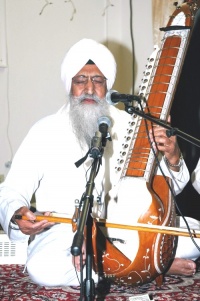Taus: Difference between revisions
From SikhiWiki
Jump to navigationJump to search
Hari singh (talk | contribs) No edit summary |
Hari singh (talk | contribs) No edit summary |
||
| Line 1: | Line 1: | ||
[[Image:Avtarsingh05 2.jpg|thumb|200px|right|Late Bhai Avtar Singh Ragi playing the Taus]] | |||
This instrument is made in the shape of a peacock and the word 'taus' is in fact a Persian word meaning peacock. It has 28-30 strings and the instrument is played with a bow. The taus is very similar to the dilruba in construction and in playing technique. However, the taus has a bigger sound box and therefore produces a much more resonant and mellow sound. It has a sound hole at the ‘tail’ portion of the instrument and stands on bird-feet carved in wood. | |||
[[Guru Gobind Singh]] (the tenth Sikh master) played this instrument and welcomed any [[rabab]] or taus player into his court. This [[saaj]] (instrument) was a favourite with late ragi [[Bhai Avtar Singh]] ji. | |||
==External Links== | ==External Links== | ||
* [http://www.geocities.com/sydney_sikhi/Traditional/strings.html | * [http://www.geocities.com/sydney_sikhi/Traditional/strings.html Traditional Sikh Musical Instruments] | ||
{{Kirtan}} | |||
[[Category:Kirtan]] | |||
[[Category:Glossary of Sikh Terms]] | |||
[[Category:Sikhism]] | |||
Revision as of 16:45, 18 January 2007
This instrument is made in the shape of a peacock and the word 'taus' is in fact a Persian word meaning peacock. It has 28-30 strings and the instrument is played with a bow. The taus is very similar to the dilruba in construction and in playing technique. However, the taus has a bigger sound box and therefore produces a much more resonant and mellow sound. It has a sound hole at the ‘tail’ portion of the instrument and stands on bird-feet carved in wood.
Guru Gobind Singh (the tenth Sikh master) played this instrument and welcomed any rabab or taus player into his court. This saaj (instrument) was a favourite with late ragi Bhai Avtar Singh ji.
External Links
| Kirtan: | Raga · Taal · Ragmala · Classical Music · Sangeet · Dhuni · Divan · Asa di Var · Jatha · Simran · Shabad · Tuk · Rababi · Dhadhi |
| Ragas: | Asa · Bairari · Basant · Bhairon · Bihagara · Bilaval · Devagandhari · Dhanasari · Gauri · Gond · Gujari · Jaijavanti · Jaitsri · Kalian · Kanara · Kedara · Maajh · Malaar · Mali Gaura · Maru · Nat Narain · Prabhati · Ramkali · Sarang · Sri · Sorath · Suhi · Tilang · Todi · Tukhari · Vadahans |
| Ragis: | Harjinder Singh · Maninder Singh · Amolak Singh · Darshan Singh · Balwinder Singh · Harbans Singh · Anoop Singh · Niranjan Singh · Amrik Singh · Avtar Singh · Snatam Kaur ·Kamaljit Kaur · Dileep Kaur · Joginder Singh · SS Maskeen |
| Saaj: | Harmonium · Tabla · · Tanpura · Taus · Rabab · Sarangi · Dilruba · · Saranda · Sarode · Sitar · Santoor · Pakhawaj · Dhadh · Dholak · Dool |

